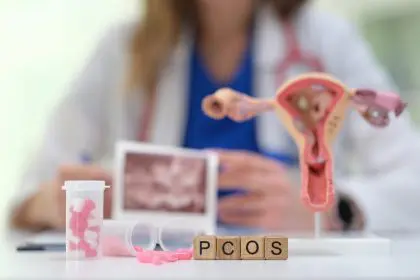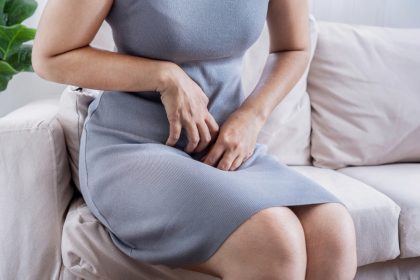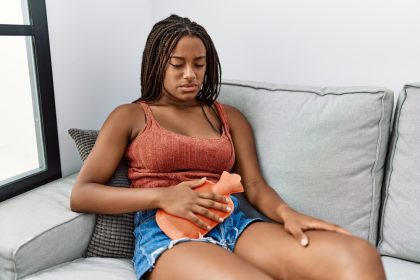These common tumors disproportionately impact women of color, but lifestyle changes can make a dramatic difference in managing symptoms
The hidden condition affecting 80% of women
Uterine fibroids remain one of the most widespread yet under-discussed women’s health issues in America today. These benign growths develop in the uterine wall during reproductive years and affect up to 80% of women of color by age 50. Despite their prevalence, many women suffer silently with symptoms that significantly impact quality of life.
These non-cancerous tumors vary dramatically in size – from as small as a pea to as large as a grapefruit – and often grow slowly over years. While some women experience no noticeable symptoms, others endure debilitating effects that disrupt daily activities and emotional wellbeing. The severity largely depends on the specific location of the fibroids within the uterine structure.
The disproportionate impact on Black women represents a significant health disparity that deserves greater attention. Black women not only develop fibroids at higher rates but also tend to experience more severe symptoms at younger ages. This racial disparity stems from a complex interplay of genetic predisposition and environmental factors, particularly those affecting hormone regulation.
Recent legislative efforts like the Uterine Fibroid Research & Education Act aim to increase funding for research and educational initiatives focused on understanding why women of color disproportionately suffer from this condition and developing safer, less invasive treatment options. This renewed attention brings hope to millions currently managing this condition.
Understanding the 3 types of fibroids and their symptoms
The location of fibroids within the uterus largely determines the type and severity of symptoms women experience. Medical experts classify these growths into three main categories based on their position within the uterine structure.
Submucosal fibroids develop just beneath the uterine lining (endometrium) and protrude into the uterine cavity. These growths directly disrupt the endometrial lining and represent the primary cause of heavy, prolonged menstrual bleeding – the hallmark symptom that leads many women to seek medical help. Some women with submucosal fibroids report flooding through protection during periods, passing large clots, or bleeding lasting longer than seven days.
Subserosal fibroids grow underneath the outer covering of the uterus, expanding outward into the pelvic cavity. Rather than causing bleeding problems, these fibroids create uncomfortable bulk-related symptoms as they press against surrounding organs. Women often experience persistent pelvic pressure, lower back pain, increased urinary frequency, painful intercourse, or constipation. These symptoms can be particularly troublesome when fibroids grow to substantial sizes.
Intramural fibroids – the most common type – develop within the muscular uterine wall itself. Depending on their growth direction, these fibroids can cause either heavy bleeding (if they grow toward the uterine cavity), bulk symptoms (if they expand outward), or both. Many women with intramural fibroids report a combination of menstrual abnormalities and pressure-related discomfort that worsens as the fibroids enlarge.
Understanding which type of fibroid you have helps explain your specific symptom pattern and guides treatment decisions. Healthcare providers typically use ultrasound or MRI imaging to precisely locate fibroids and determine the most appropriate management approach.
The estrogen connection you need to know
The growth of uterine fibroids depends heavily on hormone stimulation, particularly estrogen. This explains several key patterns observed with these tumors: their tendency to grow during pregnancy (when hormone levels surge), their typical regression after menopause (when estrogen declines), and their greater prevalence in populations with higher estrogen exposure.
Estrogen serves as a growth promoter for fibroid tissue, stimulating cell division and expansion. Multiple factors can increase lifetime estrogen exposure, including early onset of menstruation, late menopause, obesity, and environmental estrogen exposure through certain foods and products. This hormonal relationship provides important clues for managing fibroid symptoms.
Body fat plays a crucial role in estrogen metabolism. Fat tissue contains an enzyme called aromatase that converts other hormones into estrogen. This means that excess body fat essentially functions as an estrogen-producing factory, creating a hormonal environment that can accelerate fibroid growth and worsen symptoms. This connection helps explain why obesity correlates with increased fibroid risk and severity.
Environmental estrogens, sometimes called xenoestrogens, represent another significant factor. These compounds mimic estrogen in the body and come from various sources including certain plastics, pesticides, industrial chemicals, and some personal care products. Minimizing exposure to these compounds can help create a more balanced hormonal environment less conducive to fibroid growth.
Understanding this estrogen connection offers women powerful opportunities for symptom management through lifestyle modifications. By addressing factors that influence estrogen levels and activity, many women find significant relief from fibroid symptoms without resorting to invasive procedures.
The 5 natural approaches that make a real difference
Research shows that certain lifestyle modifications can significantly impact fibroid symptoms by addressing the underlying hormonal factors that fuel their growth. These natural approaches offer women practical strategies for managing this common condition.
- Regular exercise and weight management create a foundation for hormonal balance. Studies show that women who maintain healthy body weights have fewer and smaller fibroids with less severe symptoms. Excess body fat increases estrogen production, creating an environment that promotes fibroid growth. Aim for at least 150 minutes of moderate activity weekly, including both cardio and strength training. Even modest weight loss of 5-10% can reduce fibroid-related symptoms in women carrying excess weight.
- Reducing consumption of estrogenic foods helps create a more balanced hormonal environment. Conventional animal products often contain hormones that can disrupt your body’s natural balance. Limit intake of non-organic red meat, conventional dairy products, and factory-farmed chicken, which may contain added hormones or hormone-like compounds. When consuming these foods, opt for organic, grass-fed options whenever possible to minimize hormone exposure.
- Increasing anti-estrogenic foods provides natural compounds that help regulate hormone activity. Colorful fruits and vegetables contain flavonoids that block an enzyme involved in estrogen production. Cruciferous vegetables like broccoli, cauliflower, and kale contain indole-3-carbinol, which helps the body process and eliminate excess estrogen. Other beneficial foods include green tea, flaxseeds, and whole grains, which provide fiber that helps remove excess estrogen from the body through improved digestion.
- Optimizing vitamin D levels addresses a critical deficiency linked to fibroid development. This powerful hormone acts as a growth inhibitor for fibroid tissue, and research shows women with adequate vitamin D levels have smaller and fewer fibroids. Due to melanin’s filtering effect on UV radiation, women with darker skin often have insufficient vitamin D production. Ask your healthcare provider to check your vitamin D level annually and supplement accordingly if needed. Most women require between 1,000-4,000 IU daily to maintain optimal levels.
- Avoiding endocrine-disrupting chemicals reduces exposure to compounds that mimic estrogen in the body. Some hair relaxers and personal care products contain phthalates, which have chemical structures similar to estrogen and can promote fibroid growth. Choose natural hair care options and personal products free from parabens, phthalates, and fragrance. Additionally, minimize plastic food containers, especially when heating food, and opt for glass or stainless steel alternatives to reduce exposure to BPA and other plastic-derived endocrine disruptors.
These lifestyle modifications work synergistically to create a hormonal environment less conducive to fibroid growth and symptom expression. Many women report significant improvement in symptoms within three to six months of implementing these changes consistently.
When to seek medical help beyond lifestyle changes
While natural approaches provide substantial relief for many women, certain situations warrant prompt medical attention. Recognizing when to consult healthcare providers ensures appropriate care for more severe cases.
Extremely heavy menstrual bleeding that causes anemia represents a serious concern requiring medical evaluation. Signs of anemia include unusual fatigue, weakness, shortness of breath, dizziness, or pale skin. If blood tests confirm low hemoglobin levels due to excessive menstrual blood loss, medical treatments may be necessary to control bleeding and restore normal blood counts.
Severe pain that interferes with daily activities deserves professional assessment. While mild discomfort commonly accompanies fibroids, intense pain might indicate complications such as fibroid degeneration (when fibroids outgrow their blood supply) or, rarely, a different condition entirely. Accurate diagnosis ensures appropriate treatment for the specific cause of pain.
Rapid fibroid growth or sudden symptom changes necessitate prompt evaluation. While fibroids typically grow slowly, sudden enlargement might rarely indicate a different type of growth. Similarly, new symptoms developing in established fibroids warrant investigation to rule out complications or additional conditions.
Fertility concerns represent another important reason to seek specialized care. Depending on their location, size, and number, fibroids can sometimes interfere with conception or increase pregnancy risks. Women experiencing difficulty conceiving or maintaining pregnancies should discuss their fibroids with reproductive specialists who can determine whether treatment might improve outcomes.
Modern medicine offers numerous treatment options for fibroids beyond hysterectomy. Minimally invasive procedures like uterine fibroid embolization (UFE) cut off blood supply to fibroids, causing them to shrink while preserving the uterus. Various surgical approaches can remove fibroids while maintaining fertility. Medication options include hormonal treatments that temporarily shrink fibroids or control bleeding. Discussing all available options with specialists ensures informed treatment decisions aligned with personal health goals.
Living well despite a fibroid diagnosis
A fibroid diagnosis doesn’t mean resigning yourself to debilitating symptoms or major surgery. Many women successfully manage this condition and maintain excellent quality of life through a combination of lifestyle modifications, appropriate medical care, and practical coping strategies.
Knowledge empowerment serves as a powerful tool for women navigating fibroid symptoms. Understanding your specific fibroid type, size, and location helps explain your symptom pattern and informs management decisions. Track your symptoms carefully, noting patterns related to your menstrual cycle, diet, stress levels, or activities. This information proves invaluable when discussing treatment options with healthcare providers.
Period management techniques can significantly improve quality of life for women with heavy bleeding. Using absorbent menstrual products, keeping backup clothes available, planning important events around your cycle, and using waterproof mattress protection can reduce anxiety about potential leaks. Some women find period underwear or menstrual cups more effective than traditional products for heavy flow days.
Symptom-specific strategies address common fibroid effects. For urinary frequency, timed voiding (urinating on a schedule rather than waiting until urgent) can reduce disruptions. To manage pain, targeted approaches like heating pads, gentle yoga, and anti-inflammatory foods often provide relief. For intimacy challenges caused by painful intercourse, exploring different positions and timing intimacy away from peak symptom days can maintain connection while minimizing discomfort.
Emotional wellbeing deserves attention alongside physical symptoms. The chronic nature of fibroid symptoms can create frustration, anxiety, or even depression for some women. Creating space for these feelings, connecting with supportive communities (online or in-person), and working with mental health professionals when needed all contribute to holistic wellbeing while living with this condition.
With increased awareness, ongoing research, and a comprehensive approach to management, women with fibroids can maintain control over their symptoms rather than letting symptoms control their lives. The combination of lifestyle modifications, appropriate medical care when needed, and practical coping strategies allows most women to successfully navigate life with this common condition.

















